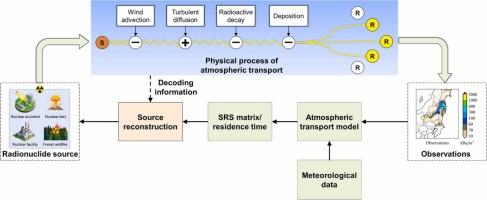大气放射性核素泄漏源重建:大气输运物理解码信息的最新进展
IF 11.3
1区 环境科学与生态学
Q1 ENGINEERING, ENVIRONMENTAL
引用次数: 0
摘要
由于计划将全球核能力增加两倍,大气放射性核素释放因其环境和公共健康影响而受到越来越多的关注。然而,在某些情况下,源位置和释放率不能直接检测,必须从环境观测中反向重建,例如2017年106Ru事件。由于控制放射性核素传输的复杂物理过程,这种重建极具挑战性。现有方法在观测和气象条件下表现出不同的性能,这在很大程度上取决于它们如何解码来自大气输运物理的源信息。然而,在以前的综述中,这种大小写敏感性仍然没有得到充分的探讨,并且在最近的泄漏事件中变得突出,这些事件具有稀疏的观察结果和有限的先验源知识。为了解决这个问题,我们确定了物理过程在解码源信息中的作用,并将重建方法分为向后跟踪和基于源受体敏感性的细化。对每一种具有代表性的信息解码方法,从其信息解码策略、优势、局限性、实用性等方面进行了分析。本文还介绍了不同方法的可能整合,以及潜在的挑战和前景,以提供该领域的全貌。这些信息为开发和应用可靠的大气放射性核素泄漏源重建方法提供了宝贵的见解,促进了核紧急情况和环境保护中的知情决策。本文章由计算机程序翻译,如有差异,请以英文原文为准。

Source reconstruction for atmospheric radionuclide leakage: Recent advances in decoding information from atmospheric transport physics
With plans to triple global nuclear capacity, atmospheric radionuclide releases have received increased attention owing to their environmental and public health implications. However, in certain cases, source location and release rates cannot be directly detected and must be inversely reconstructed from environmental observations, such as the 2017 106Ru event. Such reconstruction is highly challenging due to the complex physical processes governing radionuclide transport. Existing methods show varying performance across observational and meteorological conditions, largely depending on how they decode source information from atmospheric transport physics. However, this case-sensitivity remains underexplored in previous reviews and has become prominent in recent leakage events with sparse observations and limited a priori source knowledge. To address this, we identify the role of physical processes in decoding source information and categorize reconstruction methods into backward tracing and source–receptor–sensitivity-based refinement. For each, representative methods are analyzed in terms of their information decoding strategies, advantages, limitations, and practical applicability. Possible integration of different methods, along with underlying challenges and prospects are also presented to provide a full picture of this field. These information offers valuable insights into developing and applying reliable source reconstruction methods for atmospheric radionuclide leakage, facilitating informed decisions in nuclear emergencies and environmental protection.
求助全文
通过发布文献求助,成功后即可免费获取论文全文。
去求助
来源期刊

Journal of Hazardous Materials
工程技术-工程:环境
CiteScore
25.40
自引率
5.90%
发文量
3059
审稿时长
58 days
期刊介绍:
The Journal of Hazardous Materials serves as a global platform for promoting cutting-edge research in the field of Environmental Science and Engineering. Our publication features a wide range of articles, including full-length research papers, review articles, and perspectives, with the aim of enhancing our understanding of the dangers and risks associated with various materials concerning public health and the environment. It is important to note that the term "environmental contaminants" refers specifically to substances that pose hazardous effects through contamination, while excluding those that do not have such impacts on the environment or human health. Moreover, we emphasize the distinction between wastes and hazardous materials in order to provide further clarity on the scope of the journal. We have a keen interest in exploring specific compounds and microbial agents that have adverse effects on the environment.
 求助内容:
求助内容: 应助结果提醒方式:
应助结果提醒方式:


